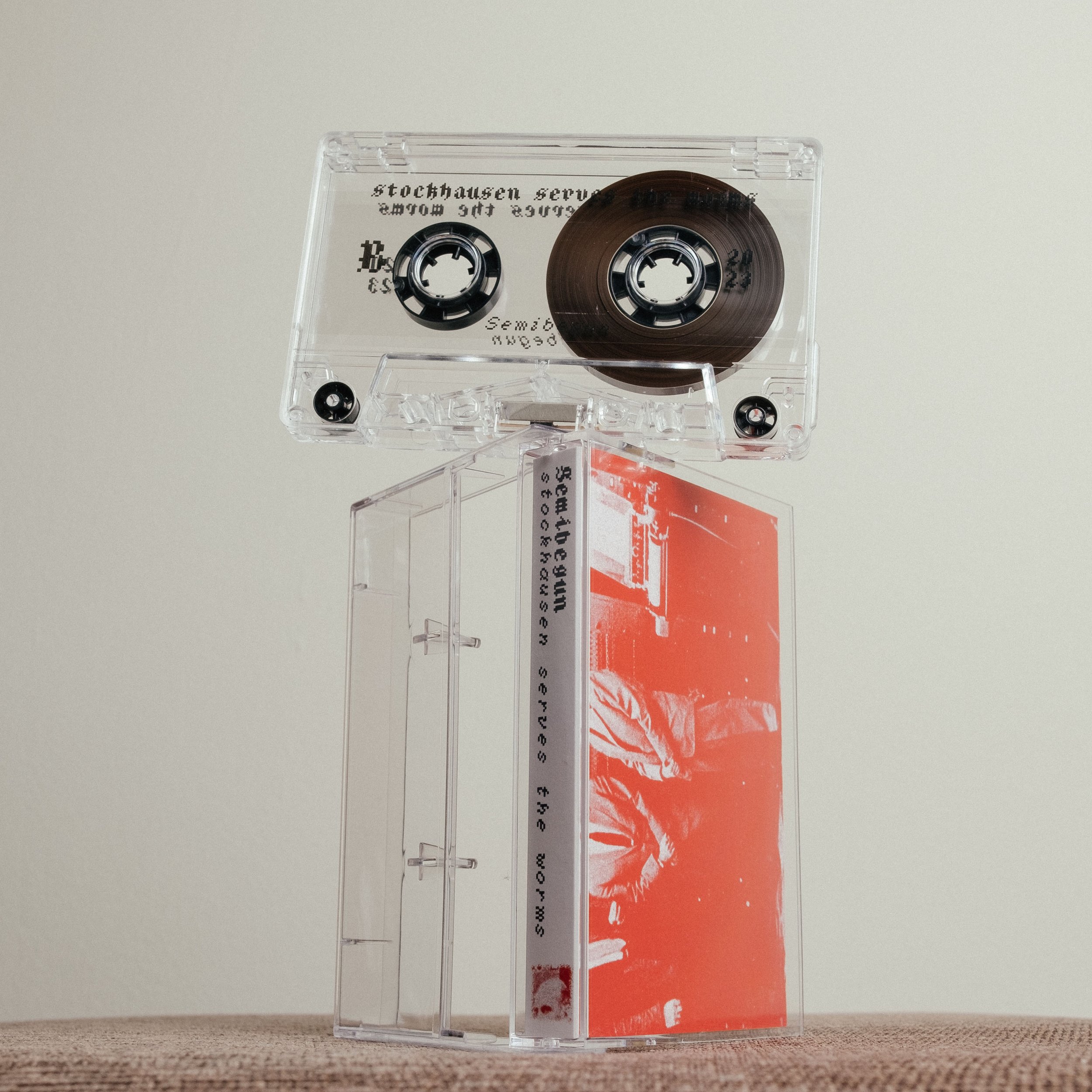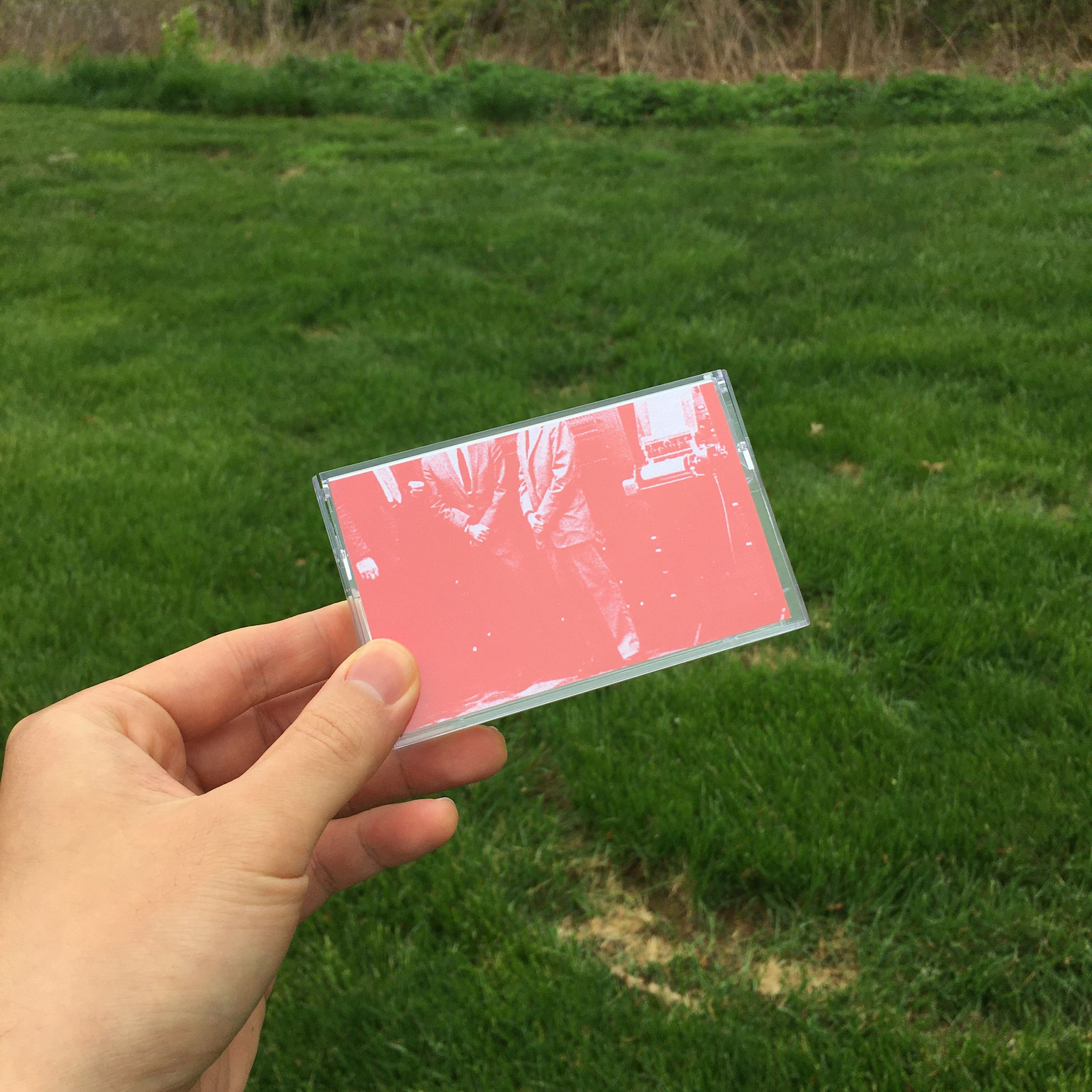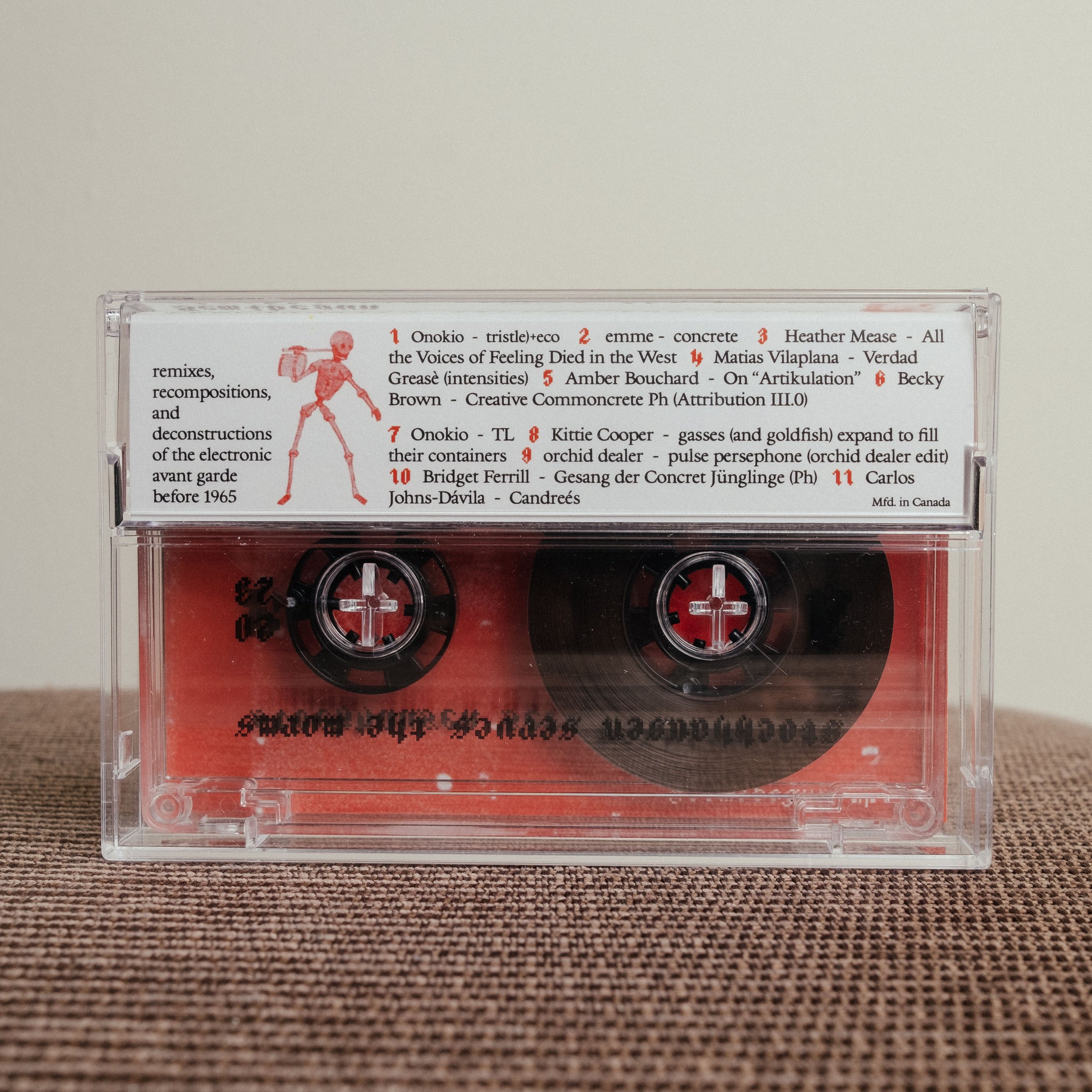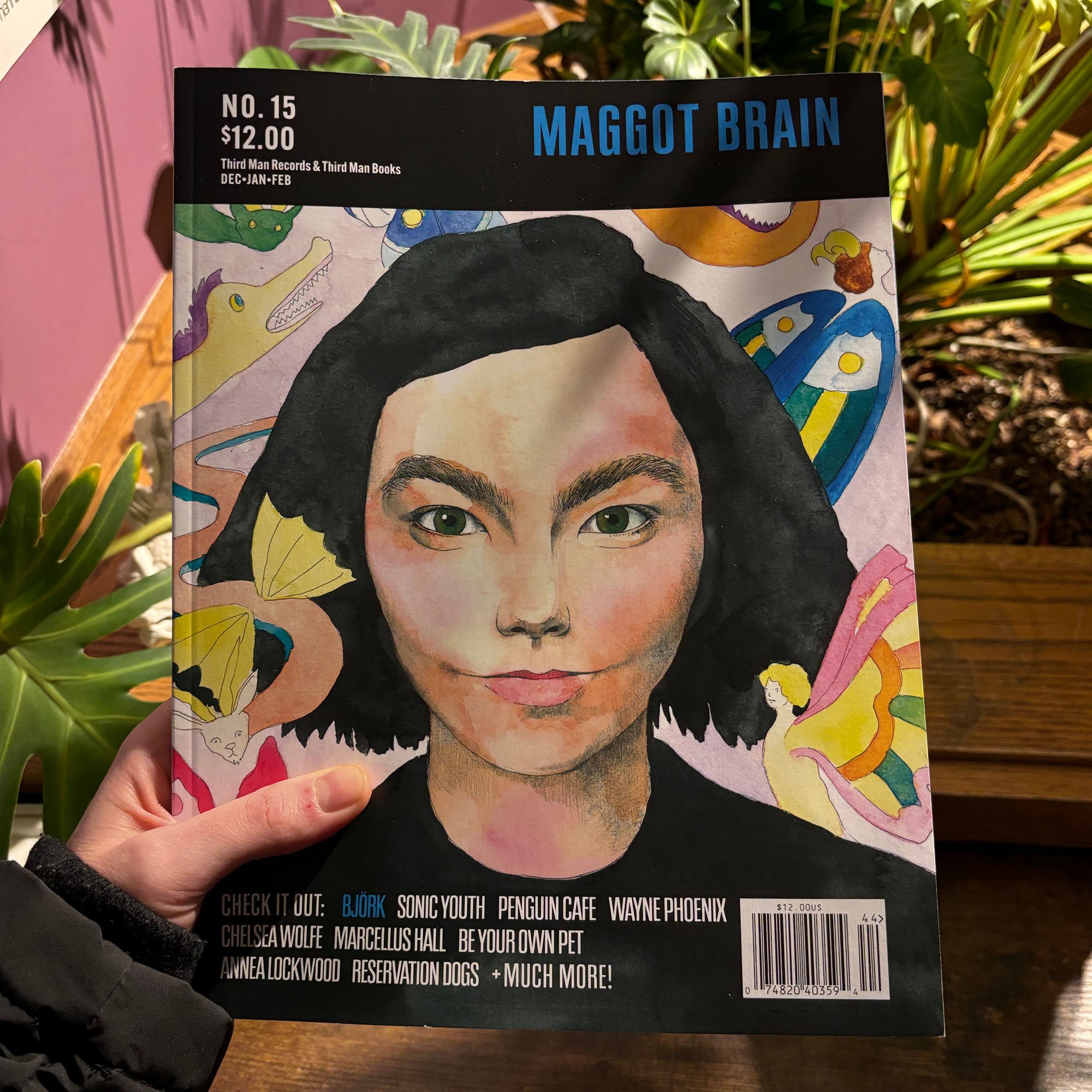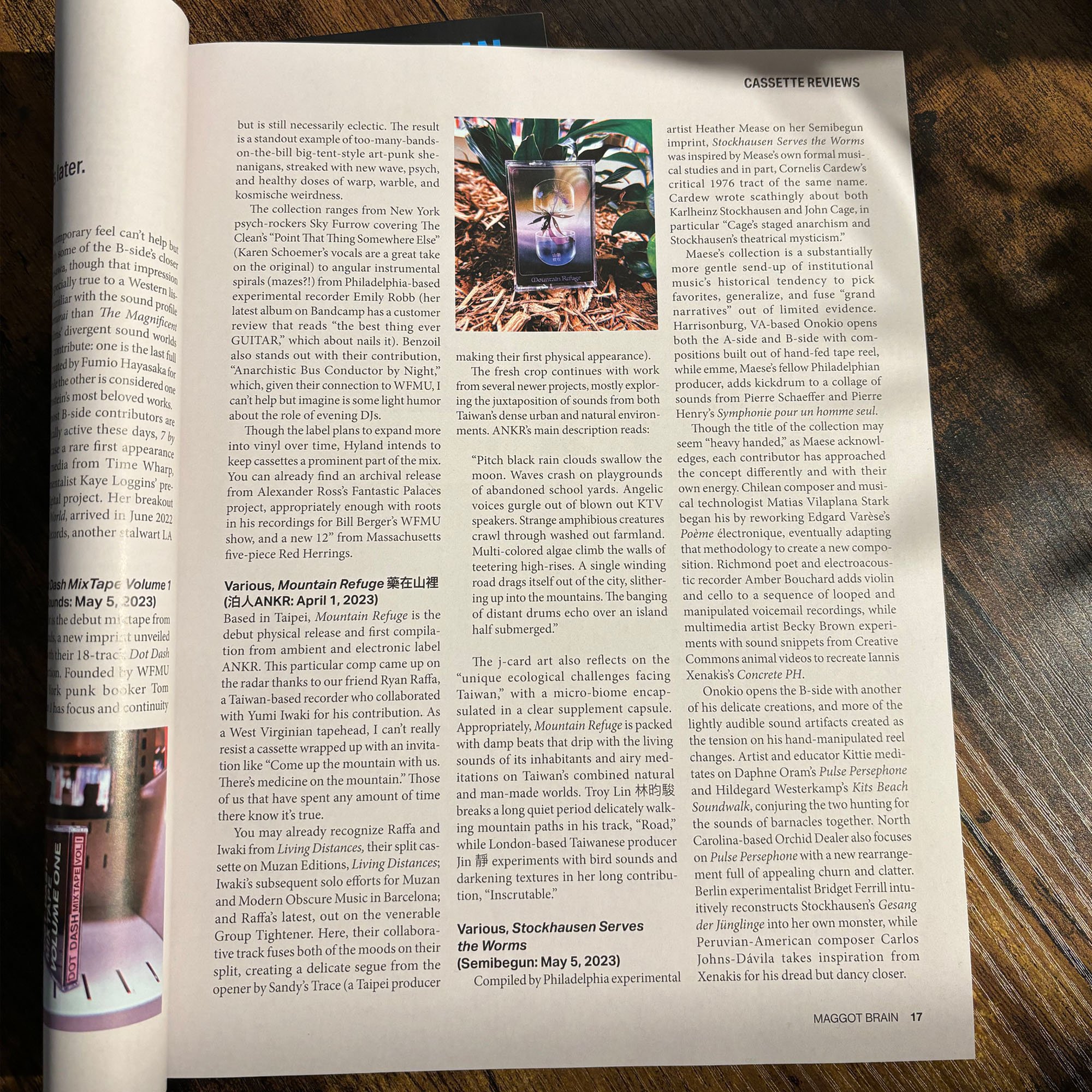STOCKHAUSEN SERVES THE WORMS
REMIXES OF EARLY AND AVANT-GARDE ELECTRONIC MUSIC
Release Date: May 5, 2023
TRACKLIST
Onokio – tristle)+eco
emme – concrete
Heather Mease – All the Voices of Feeling Died in the West
Matias Vilaplana – Verdad Greasè (intensities)
Amber Bouchard – On "Artikulation"
Becky Brown – Creative Commoncrete Ph (Attribution III.0)
Onokio – TL
Kittie Cooper – gasses (and goldfish) expand to fill their containers
orchid dealer – pulse persephone (orchid dealer edit)
Bridget Ferrill – Gesang der Concret Jünglinge (Ph)
Carlos Johns-Dávila – Candreés
Cassette available for purchase on Bandcamp. For Repeater Radio mix and more info on the project visit Semibegun 18: Stockhausen Serves the Worms.
WHO DO YOU SERVE?
Reflecting on a particular history of early electronic music, a certain narrative that often begins somewhere around Russolo's "The Art of Noises," passes through Cage’s Imaginary Landscape, Varèse in the Philips Pavilion, Stockhausen at West German National Radio, and Babbitt and Ussachevsky at Columbia-Princeton Electronic Music Center, the canon reflects back uncanny distortions like a funhouse mirror in a museum. Textbooks and survey courses tend to collapse histories into linear grand narratives that result in historical trajectories that prioritize masterworks and genius and the construction of dubious lineages. As the old guard continues to wane, the narrative changes. But the influence this certain history has had on me since my formative years as a composer remains a source of dissonance that I revisit and, however intentionally or unintentionally, never resolve. Investigation of this personal dissonance underscores the impulse for this project.
The heavy-handed title references Cornelis Cardew’s Stockhausen Serves Imperialism, a 1974 Marxist critique attacking Stockhausen as the poster child of the bourgeois avant-garde complicit in and reproducing a “cultural super structure of imperialism.”[1] He gives John Cage a good thrashing, too. The title of this project labels Stockhausen as worm food not just for provocation or as merely a statement of fact. Stockhausen Serves the Worms positions the composer and the canon of which he belongs as worm food both literally–he is buried in Kürten, under a monument engraved with an excerpt of his massive operatic cycle Licht –and figuratively as fertilizer for the decomposition and creation of new works. A meditation and exercise on influence, on how composition functions as a discipline, on intersections of music histories, on real and imagined pasts and futures of electronic music. A different approach to dragging Stockhausen’s corpse than through the streets of conservatory curricula, the project offers a mode of decomposition: literally, musically, metaphorically, breaking canonic pieces down and appropriating their parts for fertilizer in the creation and inspiration of new works.
For Cardew, the work of Stockhausen or Cage, of anyone who falls into the category of ‘genius,’ cannot be untangled from the political context of its creation and the position of its creator:
The true nature of a piece of music, like any work of art, is inextricably bound up with the ideological stand or world outlook of its creator, and that the content of a piece of music is not something mysterious, unattainable or elusive. On the contrary, creative listening, that is, listening to music that involves the mind as well as the ears and heart, can attain a measure of understanding of what a composer is saying about the world.[2]
As time passes, the context in which the listener/student contacts the work grows with increasing importance. Beyond the historical canon, the contemporary field of electroacoustic music as it exists in and around academic institutions perpetuates the “extreme lengths of intellectual corruption and dishonesty” surrounding both genius and the American academy as, first and foremost, a business.[3]
Decomposition expands “creative listening” to include remix and revision, granting access to the material of masterwork for appropriation in ways often deemed formally inappropriate. Stockhausen’s Gesang der Jünglinge, considered a landmark in the repertoire, is unmovable, a fixed work closed for participatory reinterpretation by the listener. It sits on a plinth in the electronic music museum, in the sanctuary of St. Stockhausen. Mixing recordings together to transform and shape material over time defines traditional DJing. Playing with the material of this repertoire through remix and decomposition opens new avenues to converse with a body of work that often feel alienating. The diversity and range of contemporary electronic music and its practitioners clashes with the primarily white, inaccessible (stylistically, technologically, institutionally), overwhelmingly male dominant historical narrative of early electronic music.
More radical instincts might draw the conclusion that this canon needs to retire. Even I would admit that any potentially subversive power in decomposition is undercut by its source material. In any type of appropriation, especially with any satirical or parodic intent, it’s very difficult to avoid reproducing the subject of the critique. Even if rendered completely unrecognizable, the spirit can still linger in program notes and the decomposer’s hand. As a counterpoint to an approach of complete desecration, a lot of the hits are impressive pieces of music and worthy of study. Much of the dissonance I feel towards the avant-garde rests between the willing influence this music has had on my work through genuine appreciation and the mark it has left unwitting receiver of the grand narrative. Before graduate school, I could name a few female composers but had not spent anywhere near the amount of time with their work as I did with Ligeti’s “Artikulation” or Babbitt’s “Philomel.” I learned about Daphe Oram’s Oramics but did not hear much of her work and Wendy Carlos was brushed off for creating schlocky Bach arrangements. A conservatory education can’t take all the blame and I certainly take some responsibility as a young person who had access to a large library and a smart phone. But it is also no secret that Stockhausen Serves the Worms serves an outlet for my own resentment towards a narrative that I later found intentionally misleading.
Not every artist on the compilation shares that same experience. At least one person was completely unfamiliar. Many chose a less charged approach, exploring material and form. This project is also by no means the first to reimagine, sample, and remix electronic music prior to the late-1960’s. Some Delia Derbyshire record must have floated around crate digging circles. Madlib sampled a few of her tracks on the 2014 album Piñata with Freddie Gibbs, followed by Paul White who sampled “Pot Au Feu” on the 2016 Danny Brown track “When it Rains.”
When I reached out to the participants to pitch the idea, I included a list of example pieces that included: “Gesang der Jünglinge” by Karlheinz Stockhausen, “Pulse Persephone” by Daphne Oram, “Poème électronique” by Edgard Varèse, “Artikulation” by György Ligeti, the 1964 compilation album Columbia-Princeton Electronic Music Center and a few other big names and pieces. Most of the artists stuck with these examples, but I did encourage the exploration of music beyond the list. Some stuck to one piece, others combined a few of them. A couple artists went a little more outside the box. Track 11 by Carlos Johns-Dávila uses an acoustic piece by Xenakis as starting material. He then electrifies the piece with processing and added percussion. Track 8 by Kittie Cooper incorporates Hildegard Westerkamp’s “Kits Beach Soundwalk” into the mix with “Pulse Persephone” by Daphne Oram. Although beyond the mid-60’s cut off, Cooper blends the Westerkamp with the Oram both thematically and sonically. The arbitrary cut off of the mid-to-late 1960’s was intended to keep the material within an era of a pre-socialized electronic music that was rooted in the avant-garde and institutional exclusivity. But ultimately, flexibility accommodated the exploration of individual interests, styles, and narratives: from sound collage to tape loops to two-step to ambient.
My own piece in this project captures the impetus for this project and particularly the ambivalence I feel regarding these two pieces for voice and electronic sound, Milton Babbitt's “Philomel” (1964) and Luciano Berio's “Visage” (1961). I deeply admire the craft of these works, now even more so after combing through their details note by note. Bethany Beardslee and Cathy Berberian do much of that leg work purely through sublime performance. My qualms partially stem from content and the ways in which Berio and Babbitt compose that content through the voice. However, I state that grievance not without caveats. The issue is not simply Philomel's rape and mutilation translated into the language of male-dominated austere avant-garde virtuosity (although that too leaves me uneasy). Maybe more objectionable is the context of its encounter: studying Berberian's moans in windowless classrooms packed with young men in conservatory basements, presented as landmarks of a windowless electronic music history. In the resampling process I worked through the source material with an eraser, an attempt at speculative composition and history through absence, only to occasionally recompose the same piece with the remaining scraps. The title refers to a line near the end of Philomel: "Finally, as all the voices of feeling died in the west…"
If I had to draw an actionable conclusion to this project, it would be that, if nothing else, decomposition is a great composition exercise. Like score study or learning counterpoint, making something from something comprises at least a part of most music making processes regardless of it foregrounding itself. This project does not claim a radical outcome. It cannot right wrongs. While the resulting pieces vary more stylistically than the source materials taken as a whole, the origins are still within earshot. Babbitt and his scheme of pitch selections, rhythms, and musical direction transmit through the samples of voice and the RCA Mark-II. And I can hear my own education, in the footsteps of Princeton, New York, Cologne, reproducing itself. It feels good to piss on graves and it feels good to finally locate a bit of yourself in the canon after exploration and self-insertion.
[1] Cornelius Cardew, Stockhausen Serves the Worms, (Ubuclassics, 2004), 47.
[2] Ibid., 44.
[3] Ibid., 33.
PROGRAM NOTES
1. tristle)+eco and 7. TL
"2 insomniac elixir" could be a collective descriptor for these couple tracks, it was a new adventure for me: working with tape in such an ad-hoc way; using what I had around; straying away from "THE FIXED BOX". i used my fingers to keep the tension in the tape so it fed through the machine correctly for longer loops out of the shell. you'll hear moments in tristle)+eco where my hands slipped and the sound decays / crumples away as the tape loses its position and falls out of the machine, I exploited that "error" and began using that "in-between" technique where at certain angles I could manipulate the tape in and out of the recording head, as to get irregular shapes / rhythms of sounds, patterns drawn in cold breath canvas window, sort of intentional "bumps" in the tape, or you can envision the way you can crumple up a plastic straw's paper encasing like an accordian or caterpillar before administering a water droplet to see the thing expand. i think that's why tape is still relevant, or holds a special place to some, to me at least it is the elasticity of what you can do texturally that I found most compelling. Derbyshire is the godmother of these techniques as the rest of us pick her pieces up off the floor and examine them under our own mothlights. EQUIP USED: SC-88PRO, Quadraverb, hand-me-down "The Entertainer" mixer, Fostex X-18 tape machine.
Onokio is a musician and “computer psychologist” (with a background in listening), a composer of electronic and organic sounds, and a programmer bent on bridging the imaginary gap between technology and nature by exploring combinations of frequencies.
2. concrete
To create this piece, I worked from the source material of Pierre Schaeffer and Pierre Henry’s Symphonie pour un home seul. Their piece, as its title suggests, was intended to be performed individually: by one man manipulating tape and turntables. I was drawn to working with this piece because it seemed to underscore a musical philosophy quite contrary to my own. Whereas my own musical education and my approach to musical experience is deeply collective in nature, this composition by Henry and Schaeffer seemed to be abandoning the power of collective, participatory musical experience in favor of individual technical achievement and innovation. At the same time though, the piece they created is sonically very rich and generative. So I wanted to recontextualize the sonic world they created within a more familiar, collective and danceable format. What came out of this process was something like a techno/experimental club track incorporating many different percussive elements in conversation with each other: a robust and layered rhythm section which builds over the course of the track – the kind of 'collective' instrumentation which is the basis of much of the music I make.
I sampled and manipulated the source material to varying degrees. The track I created consists almost exclusively of sampled audio, with the exception of a kick drum. All manipulation of source material was done digitally, in Ableton.
emme is a musician & percussionist based in Philadelphia.
3. All the Voices of Feeling Died in the West
The inspiration for this remix project ties directly to the ambivalence I feel regarding the two pieces sampled here for voice and electronic sounds, Milton Babbitt's Philomel (1964) and Luciano Berio's Visage (1961). I deeply admire the craft of these works, now even more so after combing through their details note by note. Bethany Beardslee and Cathy Berberian do much of that leg work purely through immaculate and terrifying performance. My qualms partially stem from content and the ways in which Berio and Babbitt compose that content through the voice. However, I state that grievance not without caveats. The issue is not simply Philomel's mutilation translated into the language of austere avant garde virtuosity. Maybe more objectionable is the context of its encounter: studying Berberian's moans in windowless classrooms packed with young men and multichannel arrays in conservatory basements, presented as landmarks of a windowless electronic music history.
In the resampling process I worked through the source material with an eraser, an attempt at speculative composition and historical revision through absence, only to occasionally recompose the same piece with the remaining scraps. The title refers to a line near the end of Philomel: "Finally, as all the voices of feeling died in the west…"
Heather Mease composes music from samples, synthesizers, violin, voice. Semibegun is the product of a love woven between early and later musics. www.hmmease.com.
4. Verdad Greasè (intensities)
I chose Poème électronique as the source material for this piece. The eclectic collection of sounds can deceptively lead one to think that it would be an excellent piece to take samples from and remix. However, once I started sampling different moments I realized that the true value of the piece was not in the particular timbres themselves, but rather the relationship between each of the different sounds. I decided to not sample any of it and rather take Varèse's approach to composition as ‘organized sound’ and carry it out with my own collection of timbre.
The collection was produced with three different synths (MiniMoog, Oberheim Matrix 12 and Arp Odyssey) in an attempt to explore their timbral range. The first half of the piece is the result of the curation and organization of this collection, using different tools to highlight the resemblances and contrasts between each of the sounds. The second half of the piece diverges from the idea of organized sound and moves closer to the idea of Zones of Intensities, also expressed by Varèse. Paraphrasing from "Liberation of Sound," he describes these zones as sound masses that move through different planes, differentiated by various timbres, colors and loudnesses, where the work can flow as rivers flow.
Matias Vilaplana Stark is a Chilean music technologist, composer, and improviser. In his music he explores different processing techniques and live looping to create slow evolving textures that coalesce into distinct soundscapes. matvilap.github.io
5. On "Artikulation"
(Artikulation - a conversation, exchange , call and response)
Foundation of looped samples from the original recording, plus new addition of cello and vocals.
Disfigured conversations with yourself, crossed wires with others, smoke signals diluted by wind, illegible. Lockable smartphone nuked the art of the pocket dial unscramble, decoding lover, friend, stranger’s 5 minute long voicemail, nobody knowing yet that you have sleepwalked your way into unintentional sonic reconnaissance. The desperate search for meaning in the garbled overlay of voices. Dissonant motion of the body among other bodies among fabric. Happy to hear laughter, and nauseatingly nervous. What is your embodied experience of being able to latch on to nothing? A syllable is not a sentence and means nothing isolated from its cohort. It takes more than a syllable to make a person and overflow a heart. I hear your voice on the radio and I keep chasing you through the channels -- dangerous hobby while driving. Broken mirrors all over the gas station parking lot, stealing propane tanks. Throwing memories around like dry snowballs; they mostly miss, or fall apart. Ache for a note tucked into a borrowed book, unambiguous.
Amber Bouchard is an acoustically-oriented electronic musician, poet, visual artist, and ice ball earth proponent based in Richmond, Virginia.
6. Creative Commoncrete Ph (Attribution III.0)
I picked Concrete Ph II because it's one of few from the Old Guard that I enjoy and would listen to without irony. The sounds of the burning charcoal are almost too monolithic to be of use – while I'm sure I could have processed them, it made more sense to do granular synthesis on something else that was similar.
Somehow in this process I started thinking about Creative Commons audio used in YouTube videos, mainly tracks by Kevin MacLeod that have become ubiquitous to the point that they've become their own tropes. Specifically, I looked for songs that are most frequently used for cute/quirky/fun/playful/bright content, like animal videos or craft tutorials. Good MacLeod examples are "Investigations," "Life of Riley," "Jaunty Gumption," and "Quirky Dog." These typically use plucked strings, pitched percussion, and "funny" wind instruments (detuned flute, oboe, bassoon) that felt like they could be easily pushed somewhere adjacent to Xenakis's charcoal.
I initially thought to use "Life of Riley"*, but granulating it blurred the ukulele to the point of being unrecognizable. "Sneaky Snitch,"** on the other hand, leaves a lot of silences, which lends itself well to a half-linear granulated experience of the original track. This description constitutes an attribution to Sneaky Snitch by Kevin MacLeod, but in keeping with the piece title, Creative Commoncrete Ph (Attribution III.0) is also released under a Creative Commons 3.0 Attribution license. It's not nearly as functional as the original, so I'm not sure it would be applicable for cat videos anymore, but it's open to anyone to use and transform. I'm sure this is what Xenakis would have wanted.
* tasting notes: fast ukulele strumming plus xylophone melody, conjures images of someone's beach vacation photo reel with diagonal page-turn transitions or a narrated timelapse of decorating cupcakes
** tasting notes: synthesized pizzicato strings with oboe countermelodies; conjures visions of narrative cat content, in which one cat, dog, child, drunken adult, trundling bug, or other conceivably mischievous ambulatory creature has been characterized as a mostly-innocuous villain with a plan described (?) to the viewer over two minutes of subtitled inner dialogue and casual skulking
Becky Brown is a composer, harpist, artist, and web designer, interested in producing intensely personal works across the multimedia spectrum. becky-brown.org
8. gasses (and goldfish) expand to fill their containers
I chose to work with Kits Beach Soundwalk (Hildegard Westerkamp, 1989) and Pulse Persephone (Daphne Oram, 1965) for this piece, alongside my own field recordings and recordings of my own DIY electronic instruments. I thought that both of these artists have a way with opening things up and looking at their insides, and I wanted to explore that aspect of both works while honoring the differences in the artists’ respective practices.
In one section of Kits Beach Soundwalk, Hildegard Westerkamp creates this beautiful fantasy that underneath the noise of Vancouver are the voices of barnacles—all you have to use to find them are your ears, and maybe a hydrophone and some filters if you’ve got access to them. This section felt especially meaningful once I moved to the city where she made these recordings. I’m starting to have a better understanding of just how much busyness and noise and container ships and barnacles are all cohabitating the messy layers of this place. Trying to dig around for the barnacle sounds has started to feel extra worthwhile.
In my imagination, Daphne Oram spent a lot of hours tinkering and opening up various hatches on the Oramics Machine and moving things around with tweezers or whacking the side of it with a wrench, like a wacky inventor from a movie. When I listen to her work, I feel like I can almost hear her shuffling around all these tiny components and bits of tape, and sticking them back together in strange configurations. I imagine Hildegard Westerkamp doing the same trying to uncover the sounds of barnacles, and I tried to channel that way of working in my reinterpretation of both of these pieces.
Kittie Cooper is a sound and intermedia artist, performer, and educator based in Vancouver, BC. kittiecooper.com
9. pulse persephone (orchid dealer edit)
I dissected Daphne Oram's piece and rearranged/processed different sections, focusing on the subtle rhythmic patterns. After adding different field recordings, I sculpted the track with a musique concrete approach attempting to create a bit of an atonal wall of haze. The main drone that flows throughout the track was shaped in an attempt to create a muted, behind the wall formula 1 engine.
Visual artist and sound designer Orchid Dealer fuses textural expressionism with lush field recordings to create fever dream-like zones sprinkled with moments from everyday life. Their record Soft Reactions in the Sun is available via enmossed.
10. Gesang der Concret Jünglinge (Ph)
To make this mashup I used a technique I often use in my composition and live performance practice — loading samples into my octatrack and intuitively building patterns out of the sounds: a sort of macro granular synthesis to construct new worlds. Normally I work with my own material (string recordings, noise, etc) and pop songs (Britney,
Evanescence), and I used that same irreverence here, working as if the source material was my own to pull apart and rebuild.
Bridget Ferrill is a composer based in Berlin. Her music plays between composition and noise, exploring augmented instruments, handmade electronics, and experimental computer music. She has released music on Subtext Recordings and ENXPL. bridgetferrill.com
11. Candreés
In this project I wanted to explore the stochastic process pioneered by Xenakis with the Moog theremini controlling a granular synthesizer in his composition, Cendrées for mixed choir and large orchestra. The material that was recorded was reorganized into this remix of a contemporary Dionysian ritual seasoned with wails and moans from the score and a heavy beat to shake ya fanny to.
Carlos Johns-Dávila is a Peruvian American composer and multimedia artist based in Brooklyn, NY. He enjoys playing theremin and Peruvian flutes. See more of his work at www.wtfxr.com.
